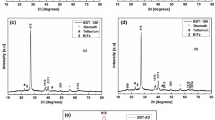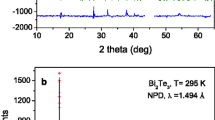We report the growth of erbium monoantimonide (ErSb) thin films on indium antimonide (100) substrates by low-pressure metalorganic chemical vapor deposition. The growth rate of ErSb thin films shows strong dependency on the growth temperature and the Sb/Er precursor molar flow rate ratio. Scanning electron microscopy, energy-dispersive x-ray spectroscopy, and x-ray diffractometry (XRD) were employed to study the ErSb thin films grown under the growth conditions that gave the maximum growth rate in the range we investigated. We also report the growth of two types of nanocomposites in which ErSb nanocolumns or nanoslabs with lengths ~500 nm and diameters 20 nm to 30 nm are embedded in Zn-doped InGaSb (ErSb/InGaSb:Zn) and ErSb nanoparticles with diameters of ~30 nm are embedded in Zn-doped InSbAs (ErSb/InSbAs:Zn). These nanocomposites were intended to increase phonon scattering in a mid-to-long phonon wavelength range to reduce lattice thermal conductivity. We used time-domain thermoreflectance to measure total thermal conductivity for the two types of nanocomposites, obtaining 4.0 ± 0.6 W/mK and 6.7 ± 0.8 W/mK for the ErSb/InAsSb:Zn and ErSb/InGaSb:Zn nanocomposites, respectively, which suggests that the thermal conductivity was close to or slightly smaller than the alloy limit of the two ternary alloy hosts. The two nanocomposites were further studied by transmission electron microscopy (TEM) to reveal their microscopic features and by XRD to assess their crystalline structures.
Similar content being viewed by others
References
I. Terasaki, Y. Sasago, and K. Uchinokura. (1997) doi:10.1103/PhysRevB.56.R12685
G. Chen, T. Caillat, M.S. Dresselhaus, G. Dresselhaus, and J.P. Fleurial (2003) doi:10.1179/095066003225010182.
C.J. Vineis, A. Shakouri, A. Majumdar, and M.G. Kanatzidis (2010) doi:10.1002/adma.201000839.
J. Lee, J. Wu, and J.C. Grossman (2010) doi:10.1103/PhysRevLett.104.016602
G. Mahan, S. Brian, and J. Sharp (1997) doi:10.1063/1.881752.
R. Venkatasubramanian, E. Siivola, T. Colpitts, and B. O’Quinn (2001) doi:10.1038/35098012.
J. Walachová, R. Zeipl, J. Zelinka, and V. Malina (2005) doi:10.1063/1.2001755.
J.M. Zide, D.O. Klenov, S. Stemmer, A.C. Gossard, G. Zeng, J.E. Bowers, D. Vashaee, and A. Shakouri (2005) doi:10.1063/1.2043241.
H. Lu, P.G. Burke, A.C. Gossard, G. Zeng, A. T. Ramu, J.-H. Bahk, and J.E. Bowers (2011) doi:10.1002/adma.201100449.
W. Kim, J.M.O. Zide, A.C. Gossard, D.O. Klenov, S. Stemmer, A. Shakouri, and A. Majumdar (2006) doi:10.1103/PhysRevLett.96.045901.
W. Kim, S.L. Singer, A. Majumdar, J.M.O. Zide, D. Klenov, A.C. Gossard, and S. Stemmer (2008) doi:10.1021/nl080189t.
W. Kim and A. Majumdar (2006) doi:10.1063/1.2188251.
D.G. Cahill, K. Goodson, and A. Majumdar (2002) doi:10.1115/1.1454111.
D.G. Cahill, W.K. Ford, K.E. Goodson, G.D. Mahan, A. Majumdar, H.J. Maris, R. Merlin, and S.R. Phillpot (2003) doi:10.1063/1.1524305.
D.C. Driscoll, M. Hanson, C. Kadow, and A.C. Gossard (2001) doi:10.1063/1.1355988.
A. Guivarch, Y. Ballini, Y. Toudic, M. Minier, P. Auvray, B. Guenais, J. Caulet, B. Le Merdy, B. Lambert, and A. Regreny (1994) doi:10.1063/1.356181.
M.P. Hanson, D.C. Driscoll, C. Kadow, and A.C. Gossard (2004) doi:10.1063/1.1639932.
C.J. Palmstrom, Annu. Rev. Mater. Sci. 25, 389 (1995).
B.E. Warren, X-ray Diffraction (New York: Dover, 1969), pp. 29–41.
D.T. Cromer and J.B. Mann (1968) doi:10.1107/S0567739468000550.
K. Hiramatsu, S. Itoh, H. Amano, I. Akasaki, N. Kuwano, T. Shiraishi, and K. Oki, Growth mechanism of GaN growth on sapphire with AlN buffer layer by MOCVD. J. Cryst. Growth 115, 628 (1991).
T.E. Buehl, C.J. Palmstrøm, and A.C. Gossard (2011) doi:10.1116/1.3549888.
Y.K. Koh, S.L. Singer, W. Kim, J.M.O. Zide, H. Lu, D.G. Cahill, A. Majumdar, and A.C. Gossard (2009) doi:10.1063/1.3078808.
S. Adachi (2007) doi:10.1063/1.2779259.
J. Feser, Scalable Routes to Efficient Thermoelectric Materials, Ph.D., University of California, Berkeley, April 2011, 110 p; AAT 3444631.
Author information
Authors and Affiliations
Corresponding author
Rights and permissions
About this article
Cite this article
Norris, K.J., Lohn, A.J., Onishi, T. et al. MOCVD Growth of Erbium Monoantimonide Thin Film and Nanocomposites for Thermoelectrics. J. Electron. Mater. 41, 971–976 (2012). https://doi.org/10.1007/s11664-012-2094-6
Received:
Accepted:
Published:
Issue Date:
DOI: https://doi.org/10.1007/s11664-012-2094-6




